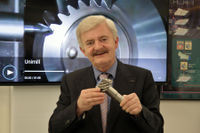
The manufacturing of differential gears went away from the Revacycle broaching process to forging more than 30 years ago. Today, where electric vehicles create a peak torque which are a multiple higher than in vehicles with internal combustion engines, the strength and the Noise Vibration Harshness (NVH) advantages of cut differential gears are revisited. The newly developed Coniflex Pro straight bevel gears combine several new features which make them stronger and quieter than past straight bevel gears and far superior to the forged version.
For cylindrical gears, speed-increasing transmission stages are well known, and regarding profile shift, preferred pressure angles, and helix angles a set of rules applies, which is not much different from the rules for speed reducers. It is important to acknowledge that basically, a speed increaser has to be designed just like a speed reducer, but then the gear with the lower number of teeth is the output. Of course, the torque and the speed of the gear with the lower number of teeth (output) and the gear with the higher number of teeth (input) must be the same as if this transmission was used as a speed reducer. In the case of straight bevel gears, spiral bevel gears, and hypoid gears the same rules apply with some additions. Spiral bevel gears have many applications as speed increasers.
Gleason's Coniflex® Pro Design and Manufacturing System for producing stronger, quieter, and more reliable e-drive differential gears in high volumes, for automotive, truck, bus and off-highway transmissions. It‘s the differential difference!
The conjugacy of meshing gears is one of the most important attributes of gears because it ensures a constant velocity ratio that gives smooth, uniform transmission of motion and torque. Some of the world’s greatest gear theoreticians like Earle Buckingham, Wells Coleman, and John Colbourne laid the foundation for understanding conjugacy. Their teachings and interpretations of the law of gearing have been used by generations of gear engineers to design and manufacture gear transmissions for almost everything that is mechanically actuated.
The fascination of the automotive differential has led to the idea to build a second differential unit around a first center unit. Both units have the same axes around which they rotate with different speeds. The potential of double differentials as ultrahigh reduction speed reducers is significant. Only the tooth-count of the gears in the outer differential unit must be changed in order to achieve ratios between 5 and 80 without a noticeable change of the transmission size.